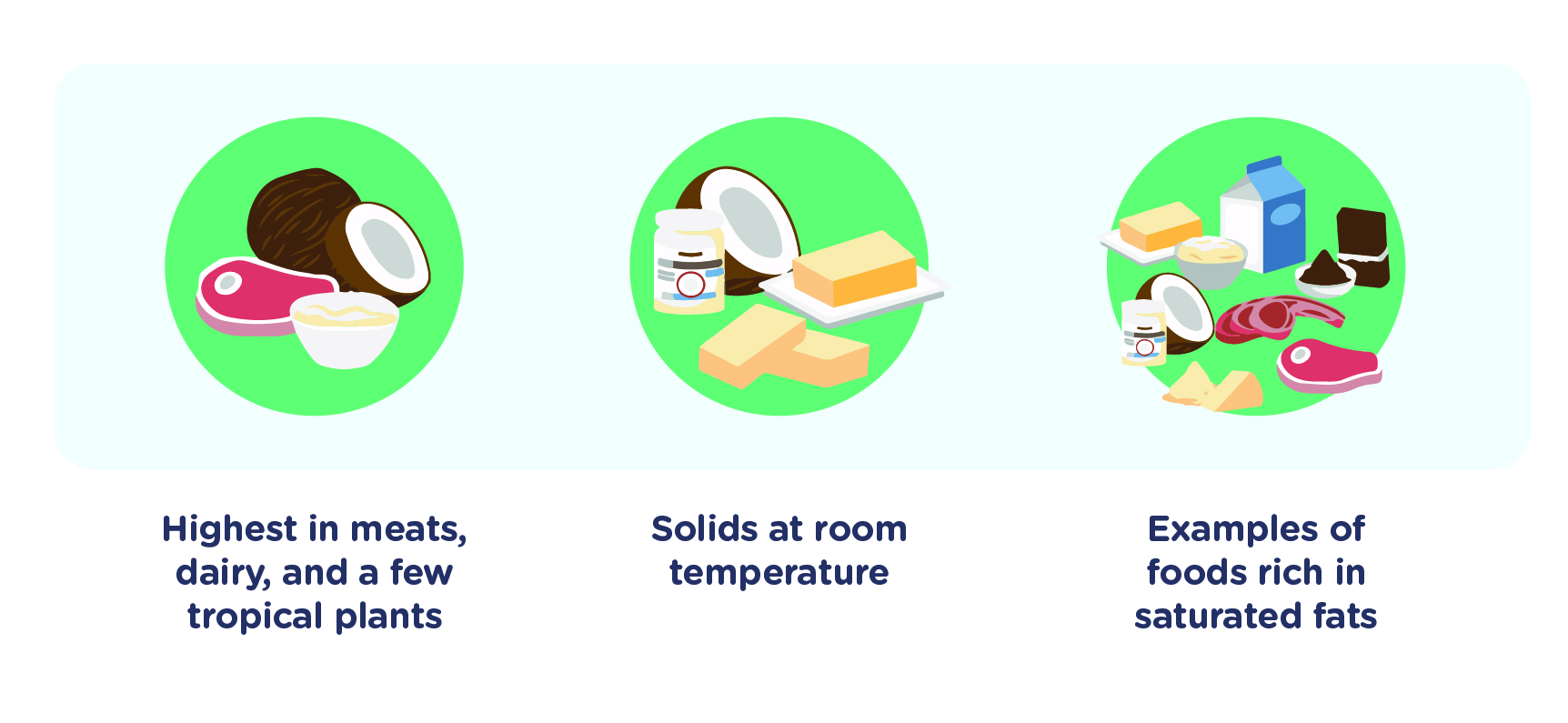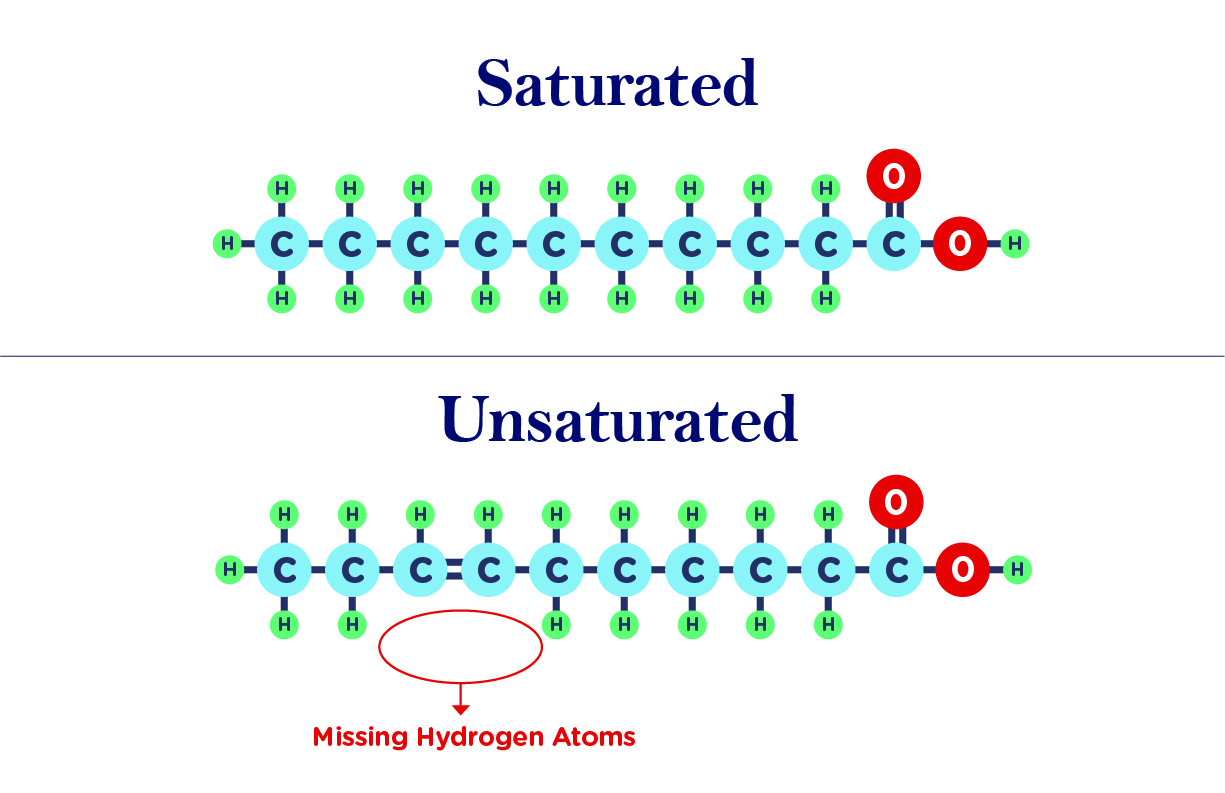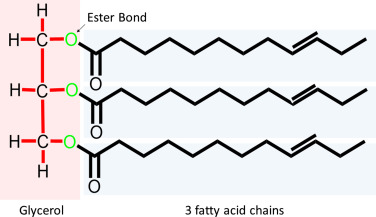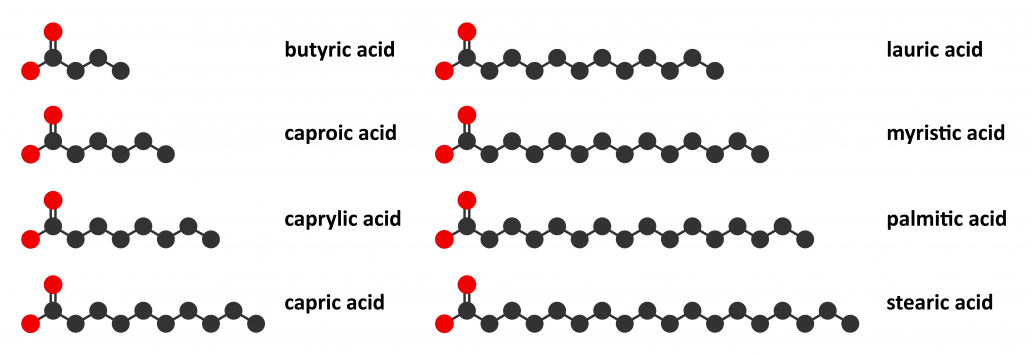We include products in articles we think are useful for our readers. If you buy products or services through links on our website, we may earn a small commission.
What is Saturated Fat? Is it Good or Bad?

The question of whether saturated fat is good or bad for our health is undergoing a much-deserved re-evaluation.
Since the 1950s saturated fat has been villainized as a leading cause of heart disease and cancer. Yet higher numbers of Americans are obese now than ever before. And heart disease and cancer are still killing over a million people every year.
So does avoiding dietary saturated fat do anything to make humans healthier?
And just as important, could it be that saturated fat is actually good for us?
Let’s find out…
Table of Contents
What is Saturated Fat?
Saturated fats (SFAs) are fat molecules with stable chemical structures (more on this later). In our diets, these fats are found in abundance in red meat and full-fat dairy products. Conversely, the fats of plants and fish are generally unsaturated.
Saturated Fat Foods
Popular examples of foods rich in saturated fats include:
- fatty cuts of meat like ribeye and lamb chops
- heavy cream
- beef tallow
- butter
- cheese
- coconut oil
- dark chocolate

Saturated Fats: Fast Facts
- Saturated fats are found in many whole foods like animal meats, full-fat dairy, and tropical fruits like coconut and cacao.
- Biochemically speaking, these fats are called “saturated” because each carbon atom they’re composed of is saturated with hydrogen atoms. This, in turn, affects how they are processed in the body. It also makes them resistant to oxidation
- Saturated fats are satiating, eating them reduces food cravings, especially for carbs
- When reviewing the evidence, scientists have found no association between consuming saturated fats and heart disease.
- Saturated fats are often high in fat-soluble vitamins A, D, E and K. Higher intake of vitamin K is associated with reduced rates of heart disease
- 60% of your brain is made of fat. 50% of the fat in your brain is saturated, and critical for cognitive function
- Saturated fats are the building blocks of many key hormones
- Cell membranes are 50% saturated fat
- Medium-chain fatty acids have been shown to reduce “bad” LDL particles, reduce inflammation, and fight bacteria
- Saturated fats can increase HDL, the “good cholesterol”
- Eating more saturated fat combined with reducing carbs can increase LDL particle size–a good thing for your heart
What Defines a Saturated Fat?
The molecular makeup of saturated fats is important because it determines how our bodies process them. In turn, the way they’re processed determines how they affect our health.
Biochemically speaking, saturated fats are defined as fat molecules (AKA fatty acids) with stable chemical structures.
These fatty acids feature single-bonded carbon molecules. It’s these single bonds that earn these fats their name; each carbon chain is “saturated” with hydrogen atoms.
You can see an example of these saturated carbon molecules in the diagram below.

The fact that these fatty acids are saturated makes them “stable”, meaning that they’re less reactive to other molecules.
In contrast, other types of fat like monounsaturated and polyunsaturated fats have at least one double bond. See image above.
This matters because the type and length of these bonds changes how your body processes each type of fat. This, in turn, affects our health.
Many of the effects can be beneficial, while some can be negative–which we’ll get into shortly.
Are Saturated Fats Triglycerides?
Typically, both saturated and unsaturated fatty acids exist as triglycerides. A triglyceride is a molecule made of three fatty acids attached to a spine of glycerol. That’s why doctors refer to the fatty acids in your blood as your triglyceride levels.

from sciencedirect.com
Triglycerides are commonly referred to as “fatty acids” and “fats” because the fatty acid parts of the molecules are responsible for how your body processes triglycerides.
There are a number of different saturated fatty acids (triglycerides). Each type is categorized and named based on its number of carbon molecules.
For example, a saturated fat found in coconut oil called palmitic oil has 16 single-bonded carbon atoms. Whereas capric acid, which is also found in coconut oil as well as breast milk, has 10 single-bonded carbon atoms.
The Three Types of Saturated Fatty Acids
Capric and palmitic are two of many other specific saturated fatty acids. Every fatty acid is categorized into one of three main groups:
- short chain fatty acids
- medium chain fatty acids
- long chain fatty acids

Short chain fatty acids (SCFAs)
Short-chain fatty acids have only 2-5 carbon atoms. They’re produced in your body when beneficial gut bacteria ferments fiber in your colon.
These fatty acids including butyrate, propionate, and acetate, are a source of energy for the cells lining your colon. Butyrate can also be found in small quantities in butter and full-fat dairy.
Examples of Short-chain Fatty Acids
- Acetic acid: Created from the fermentation of soluble fiber in the gut, this saturated fat has been shown to have powerful anti-inflammatory properties while playing a key role in digestion of glucose (blood sugar). For diabetics, ingesting acetic acid in vinegar has been shown to reduce insulin resistance.
- Propionic acid: Another fatty acid produced by the fermentation of soluble fiber, this 3 carbon molecule is converted by the liver into glucose. Though often overlooked by researchers focusing on butyric acid, propionic acid has been shown to lower fatty acids in the liver and blood (i.e. triglycerides), reduce hunger and inflammation, and improve insulin sensitivity.
- Butyric acid: Made up of four carbon atoms.Like other short-chain fatty acids butyrate is produced by fermentation in the gut, and is also found in butter and some animal meats. Butyrate has anti-inflammatory properties, increases insulin sensitivity, and may reduce neurodegenerative diseases. It has also been shown to to be helpful in treating colon diseases such as IBS, Crohn’s, and ulcerative colitis.
Medium chain fatty acids (MCFAs)
More popularly known as MCTs (for medium chain triglycerides), MCFAs are composed of 6-12 carbon atoms. Compared to most of the fat we consume, MCFAs are relatively small molecules.
The small size of MCFAs allows them to be digested more easily in the liver where they are converted to ketones–the fuel molecules your body makes from fat.
Examples of Medium-chain Fatty Acids
- Caprylic acid: With 8 carbons, it comprises 12% of the MCTs found in coconut oil. Caprylic acid is small enough to go directly to the liver where it’s converted to ketones.
- Lauric acid: A 12 carbon fatty acid makes up 42% of coconut oil. Lauric acid follows similar digestive pathways to long chain fatty acids, and like these larger molecules, it can increase both “good” HDL cholesterol, and “bad” LDL cholesterol.
- Capric acid: At 10 carbon atoms, capric acid makes up 10% of MCTs in coconut oil. It’s small enough to travel directly to the liver where it can be converted into ketones.
Long chain fatty acids (LCFAs)
Long chain fatty acids make up the majority of our fat intake. These fatty acids have 13 or more carbon atoms. In addition to most saturated fats, this category includes all monounsaturated fats and polyunsaturated fats.
Examples of Long-chain Saturated Fatty Acids
Myristic acid
A 14-carbon saturated fatty acid, myristic acid is found in small amounts in most animal and vegetable fats. Some of the most common sources include coconut, palm, and nutmeg oils, and butterfat.
When compared with palmitic acid or carbohydrates, myristic acid has been shown to cause a significant increase in total cholesterol and (bad) LDL cholesterol. It does not appear to affect HDL (good) cholesterol levels.
Though coconut and palm kernel oil are relatively high in myristic acid, they also contain other fats that may offset myristic acid’s negative effects on cholesterol.
Stearic acid
As the second most common fat in the American diet, stearic acid is found in animal fat along with coconut and palm oil. Compared with carbs or other saturated fats, stearic acid slightly lowers LDL (bad) cholesterol, or has a neutral effect.
Considered a healthy saturated fat, stearic acid shows no evidence of raising your risk of heart disease.
Palmitic acid
This 16-carbon fatty acid is the most common saturated fat in animals and plants, accounting for ¼ of the fat in dairy and red meat. As such, it makes up over half the total saturated fat intake in the American diet. It is also the most common SFA in the human body.
When compared to eating carbs and unsaturated fatty acids, palmitic acid has been shown to raise cholesterol and LDL while not affecting HDL. However, the greatest increase was seen in LDL with large particle sizes which are not a significant risk factor for cardiovascular disease.
Conversely, some research has shown that replacing long chain fatty acids with polyunsaturated vegetable oils high in omega-6’s can increase the most harmful type of LDL–small dense LDL particle levels.
It’s also important to note that in research where replacing saturated fat with linoleic acid lowers cholesterol levels, researchers conclude that this lowering “does not support the hypothesis that this translates to a lower risk of death from coronary heart disease or all causes.”
One of the reasons for this is that polyunsaturated fats have “unsaturated” chemical bonds, which makes them less stable, and therefore vulnerable to oxidation. Oxidized fats can become toxic, increasing inflammation and contributing to atherosclerotic plaque buildup.
Is Saturated Fat Good or Bad? Key Takeaway
When looking at the available science, it becomes clear that saturated fats are not objectively unhealthy. And they certainly do not deserve to be vilified and avoided, as many mainstream nutrition “experts” would have it.
So where did this unwarranted reputation come from?
How Saturated Fat got a bad reputation
Our cultural belief in the dangers of saturated fat started in the 1950s, when a few powerful medical experts were able to convince health institutions and the media that saturated fat was the cause of heart disease.
At that time heart disease had been the leading cause of death in the United States since 1910. During the late 1940s, several factors had researchers looking at cholesterol as a cause for heart disease.
- Heart disease mortality rates started trending back to previous levels after they had gone down during WWII.
- The discovery of a rare genetic condition called hypercholesterolemia in the late 1930s that leads to high cholesterol in the blood.
- The discovery that arterial plaques contained cholesterol in abundance
Back then scientists thought that the cholesterol we ate raised cholesterol blood levels.
Then an influential scientist named Ancel Keys announced his research that this was not the case.
In 1952 keys presented his “diet-heart hypothesis”, which stated that dietary saturated fat was the true cause of heart disease. His idea was that eating saturated fat increased blood cholesterol, which increased arteriosclerosis.
One of those physicians who took notice was Paul Dudley White–the nation’s top cardiologist.
Keys’ ideas exploded into the mainstream after President Eisenhower had his first heart attack in 1955. Dr. White treated the President, and the very next day, he held a press conference. He declared on national TV that all Americans should stop smoking and reduce the amount of saturated fat and cholesterol they ate.
It was the first time the press would publish the idea that heart attacks were caused by cholesterol and saturated fat. Even though the link between dietary and blood cholesterol had already been debunked!
White continued to beat this drum for Keys and supporting of the “diet-heart hypothesis”. And it worked. In January of 1961, Time Magazine put Keys on its cover and the idea that saturated fat is bad for the heart was cemented in the American psyche.
Diet-heart Dissenters
But not everyone was impressed with Keys hypothesis. Several physicians and researchers pointed out that there were countries and populations like France where saturated fat intake was high, but heart disease was low.
Others pointed out that sugar consumption in the US had gone up more than 800 percent since 1915.
The sugar industry responded to this revelation by paying some researchers to publish studies saying that saturated fat, not sugar was the cause of heart disease.
The Famous/Infamous Seven Countries Study
Nevertheless, the relationships that Keys had built with White and other members of the government helped him secure major funding for more research.
In 1970, Keys published his Seven Countries epidemiological study. In this study, Keys chose 22 countries and looked at data comparing the consumption of saturated fat to blood cholesterol levels.
He identified seven countries in which saturated fat and heart disease had some correlation. From these findings, Keyes claimed to have proven that there was a correlation between saturated fat consumption and deaths from heart disease.
What Keys neglected to mention was that the previous criticism of his data was still true. Data from sixteen other countries and populations contradicted his hypothesis.
Despite the shortcomings of his analysis, his hypothesis prevailed in American culture. With the mainstream media’s help, a growing interest in cardiology research, and the aggressive, confident personality of Ancel Keys, the diet-heart hypothesis was billed as the cure for the American heart disease epidemic.
The Truth About Saturated Fat
But the truth is slowly coming to light. Dietary saturated fat is very different from the saturated fat our bodies make. More recent research is revealing that there is a big difference when it comes to health.
A 2014 study looked at data from the larger EPIC study assessing the levels of various saturated fats in blood plasma samples taken from over 16,000 people. The researchers looked at the correlation of the types of fat with new onset of type 2 diabetes in that same group and found that odd-chain SFAs (meaning fatty acids that contain odd numbers of carbon atoms) were associated with a lower incidence of type 2 diabetes. In contrast, even-chain SFAs were associated with higher rates of type 2 diabetes.
So what? You might be asking
These findings are important when you consider that odd-chain SFAs are mostly found in high-fat dairy products such as cheese and yogurt, while even-chain SFAs are strongly correlated with the consumption of carbohydrates such as soft drinks, desserts, and potatoes.
Along with alcohol, these high-carb foods increase de novo lipogenesis. This is the process where your liver turns excess carbohydrates into even-chained saturated fatty acids for storage on the body.
Additional research is revealing that these liver-generated even-chain SFAs are linked to higher LDL cholesterol and other markers of heart disease.
Setting the Record Straight on Saturated Fats
In light of many of these findings, a bellwether 2020 paper published in the prestigious Journal of the American College of Cardiology, concluded that “Whole-fat dairy, unprocessed meat, eggs, and dark chocolate are SFA-rich foods with a complex matrix that are not associated with increased risk of cardiovascular disease. The totality of available evidence does not support further limiting the intake of such foods.”
That’s a remarkably powerful statement coming from one of the most well-respected medical journals. Especially considering that it flies in the face of 70 years of mainstream dietary advice.
So how did the researchers come to these conclusions?
By looking at all the variables in past studies and comparing them to recent studies that control for things like:
- the amount and types of foods people were eating.
- the sources of saturated fat
- how the rest of a person’s diet changes when they increase saturated fat
In earlier studies, saturated fat from a steak might be counted the same way as the saturated fat in processed low-nutrient junk foods like cookies and baked goods. Foods that are packed with sugar and all sorts of unnatural ingredients would drive de novo lipogenesis.
It’s also worth mentioning that there is a metabolically significant difference between saturated fats in meat and fats made from hydrogenated vegetable oils.
There is also a major difference between eating saturated fat along with loads of sugar and eating saturated fats while cutting out carbs.
The Hong Kong Conundrum
For more evidence challenging the saturated fat and heart disease model, we need look no further (though pretty far from America) than Hong Kong.
The average person in Hong Kong consumes 695 grams (1.5 lbs) of meat per day. And they consume the third-highest amount of red meat in the world.
Based on popular misconceptions about saturated fat (and red meat more generally) you’d expect the people of Hong Kong to be dropping like flies from heart disease and cancer.
But on the contrary, they have the longest life expectancy of any nation, at 84.5 years.
Think Hong Kong is too small of a sample size. Let’s take a look at all the available data on all of Europe!
The 2008 edition of the official European Cardiovascular Disease Statistics shows that saturated fat intake is negatively correlated to heart disease in Europe.
Why We Need Saturated Fat
So if saturated fat isn’t actually killing us, what does it do in our bodies?
Let’s begin at the beginning: The fact that human breast milk is about 54% saturated fat is one indication that Nature thinks we need it. The list below details why we should agree with nature.
- Cardiovascular risk factor improvement: You may have heard that higher HDL cholesterol in your blood is a good thing. Physicians also check Lp(a) (low-density lipoprotein) levels. Having lower Lp(a) is generally healthier bc it’s a carrier for oxidized phospholipids in our blood plasma.
Oxidized lipids can embed themselves in your arterial walls creating atherosclerotic lesions–not a good thing.
The good news is that consuming saturated fat reduces the levels of lipoprotein (a) in your bloodstream and increases “good” HDL cholesterol. The overall effect is improvement of our heart disease risk factors.
- Liver protection: saturated fats protect the liver from the effects of alcohol and drugs. Combined with a low carb diet, consuming SFAs can alleviate fatty liver disease.
- Healthy lungs: a phospholipid fat made up of saturated palmitic acid keeps the suface of the lungs supple and protects them from irritants.
- Cell and Brain health: the phospholipids that make up all of our cellular membranes are composed in large part of saturated fatty acids.
In some areas of the human brain, in more than 80 percent of the phospholipids, over half of the fatty acids are saturated fatty acids.
Myristic acid, a saturated fatty acid in milk products is essential for many cellular signaling pathways.
- Human milk fat is about 50% fat, and about half of that is saturated fat. They provide plenty of energy for newborns, and spare protein for building little bodies. Children who are put on low-fat diets develop growth and other health problems.
- Vitamin intake: saturated fats in various animal foods carry fat-soluble vitamins A and D into the body in forms that are more easily absorb and utilized.
In countries where intake of animal foods such as eggs and butter are low, vitamin A deficiencies are a problem.
Is Saturated Fat Good or Bad for You: The Outlook
So is saturated fat good or bad for you?
The totality of the evidence makes a strong case that yes, saturated fat, when consumed from natural whole foods, is healthy and may protect against heart disease and prolong life.
However, eating a standard America diet high in added sugars and highly processed carbohydrate-rich foods can cause your body to produce unhealthy saturated fatty acids that can contribute to heart disease.
SFAs can also be unhealthy in people who have one or more genetic variants that make them vulnerable to higher LDL.

















